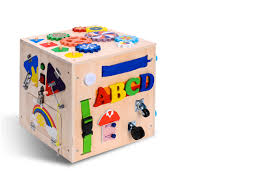The Educational Value of Busy Boards for Toddlers and Young Children
Busy boards have gained popularity as an engaging, hands-on activity for toddlers and young children. These activity boards are designed to promote learning through play by providing a variety of interactive elements such as latches, buttons, zippers, wheels, and mirrors. By offering a fun and stimulating way for children to explore and learn, busy boards have become an essential tool for early childhood development. This article will explore what busy boards are, how they benefit child development, and why they should be a staple in every toddler’s playtime.
What is a Busy Board?
A busy board is an interactive educational tool designed for young children, typically toddlers, to explore and play with various objects and mechanisms. It usually consists of a flat surface (often made of wood) with various objects attached to it. These objects can include latches, locks, buttons, wheels, lights, switches, and different textured materials. The idea is to provide children with the opportunity to explore and manipulate these objects to help them develop both physical and cognitive skills.
Busy boards are designed with safety in mind and are typically made from non-toxic materials, ensuring that they are suitable for toddlers and young children. The boards come in different shapes, sizes, and themes, allowing for customization based on a child’s developmental stage and interests.
How Busy Boards Support Child Development
Busy boards provide numerous benefits for early childhood development, including enhancing motor skills, cognitive abilities, and sensory development. Let’s take a closer look at how these educational tools contribute to a child’s growth.
1. Fine Motor Skills Development
One of the most significant benefits of busy boards is the promotion of fine motor skills. Fine motor skills refer to the ability to use small muscles in the hands and fingers to perform tasks such as grasping, pinching, or manipulating objects. Busy boards feature various interactive elements, such as buttons, zippers, and locks, that encourage toddlers to use their hands and fingers to open, close, twist, and turn. These activities help improve hand-eye coordination, dexterity, and finger strength—skills that are essential for everyday tasks like writing, eating, or buttoning a shirt.
2. Sensory Stimulation
Busy boards are designed to provide sensory stimulation through a variety of textures, colors, and sounds. As toddlers interact with the different elements, they engage multiple senses simultaneously. For example, a child may feel the rough texture of a velcro strap, hear the sound of a button being pressed, or observe the vibrant colors of different components. This sensory input helps children develop a better understanding of their surroundings and enhances sensory processing, which is crucial during the early years of life.
3. Cognitive Development and Problem-Solving
The activities on a busy board encourage children to think critically and solve problems. For example, figuring out how to unlock a latch or open a clasp requires both patience and problem-solving skills. As children manipulate different objects, they begin to understand cause-and-effect relationships, such as pressing a button that produces sound or turning a wheel that causes movement. These activities stimulate brain activity and help develop cognitive abilities, including memory, concentration, and logical thinking.
4. Encouraging Independent Play
Busy boards provide toddlers with an opportunity for independent play. As children explore the various elements on the board, they engage in self-directed learning and enjoy hours of distraction-free play. Independent play fosters creativity, concentration, and self-confidence. Children learn to focus on a task, use their imagination, and explore their interests at their own pace. This form of learning also allows children to experience the satisfaction of completing a task on their own, which is a huge confidence booster.
5. Social-Emotional Development
While busy boards can be used for solo play, they can also be a great tool for cooperative play with siblings or parents. Toddlers can share the board with others, take turns, and practice important social skills such as communication and cooperation. These interactions help improve a child’s social-emotional development, teaching them how to work with others and navigate social situations.
Why Busy Boards Are Important for Early Childhood Education
Busy boards are a great addition to any educational setting, from home play areas to classrooms. They provide young children with a hands-on learning experience that cannot be replicated through passive play. Unlike television or tablet-based games, busy boards allow children to actively engage with the world around them and develop physical, cognitive, and emotional skills.
The versatility of busy boards also makes them suitable for a wide range of ages and abilities. For example, younger toddlers can explore simple latches and buttons, while older toddlers may enjoy more complex activities, such as learning how to operate a multi-step lock or matching shapes to corresponding holes. This adaptability ensures that busy boards remain an engaging and effective tool as children grow and develop new skills.
Conclusion
Incorporating busy boards into a child’s daily routine offers a wealth of educational benefits. From developing fine motor skills and cognitive abilities to fostering sensory awareness and independent play, busy boards serve as an essential tool for early childhood development. They provide children with a stimulating, interactive environment that promotes learning through hands-on experiences. Whether used in the home or in a preschool setting, busy boards are an enjoyable, effective way to support a child’s growth and development in the crucial early years.




